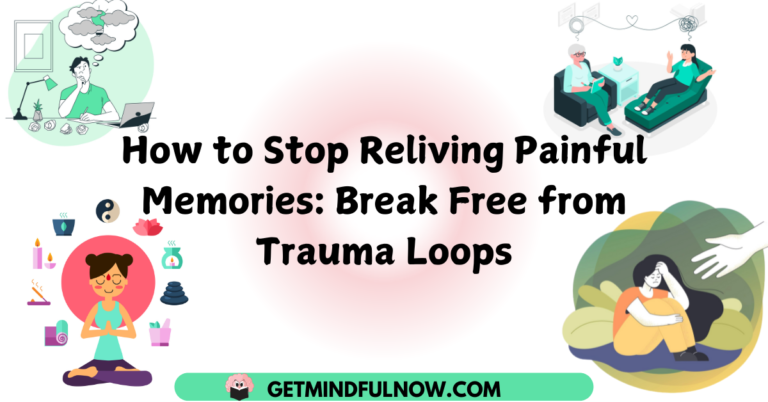Have you ever caught yourself trapped in the same painful memory, playing it over and over like a scene from a movie you never wanted to watch in the first place? You tell yourself to stop thinking about it, to move on, but your brain doesn’t listen. It feels like the past has a grip on you, tightening every time you try to break free. I know that feeling. And I also know that breaking the cycle is possible.
Why Does Trauma Keep Replaying in Your Mind?
Let’s get one thing straight: your brain isn’t trying to torture you. It’s actually trying to protect you. Neuroscientists have found that our brains treat memories of traumatic events as if they’re happening right now. The amygdala—the part of your brain responsible for detecting threats, stays hyperactive after trauma. When it detects anything even remotely similar to your past pain, it sets off alarms. Your heart races, your muscles tense, and before you know it, you’re reliving the experience all over again.
And it doesn’t stop there.
Your prefrontal cortex, the rational part of your brain that helps you distinguish between past and present, shuts down when you’re overwhelmed with stress. That means even if you logically know you’re safe, your body doesn’t get the memo. This is why someone who was in an abusive relationship might panic when they hear a raised voice, or why a car accident survivor flinches at the sound of screeching brakes.
My Own Battle With Reliving the Past
For years, I struggled with replaying painful moments in my mind. A conversation where I was humiliated, a betrayal I never saw coming, the moment I realized someone I trusted wasn’t who I thought they were. Each time, my body reacted as if it was happening all over again. My stomach would clench, my heart would pound, and I’d spiral into frustration, wondering, Why can’t I just let it go?
But one incident shook me to my core. I ran into a close relative, someone I had convinced myself would be different this time. She had betrayed me before, hurt me in ways I never imagined, and humiliated me deeply. But time had passed, and somehow, I expected things to change. I was wrong.
She did it again. Right in front of me. The same cold, cutting words, the same cruel disregard for my feelings. And just like that, I was transported back to the past. My body reacted before my mind could process it. For two days, I was a complete mess. Big tears rolled down my face, and I couldn’t function. My brain kept replaying the scene on an endless loop. I wasn’t just remembering the past, I was back in it, drowning in the same pain all over again.
But then, something shifted.
I realized she didn’t succeed in destroying me. She saw me flourishing, and it made her act out. That wasn’t my weakness, it was hers. And most importantly, I understood: I am no longer in the past. I am safe now. I couldn’t let old wounds dictate my present.
So, I turned to deep meditation, allowing myself to let go of the event. I used EFT tapping to release the raw, suffocating emotions from my body. Slowly, the grip of that memory loosened. It didn’t hold power over me anymore. Now, when I revisit it, it’s no longer pain, it’s wisdom.
Watch this Young Lady below who overcame her past and create a formative mile for us…
Step 1: Catch Yourself in the Loop
The first step to breaking free is to recognize when you’re caught in the replay. It sounds simple, but it’s powerful.
Try this: The next time a painful memory resurfaces, pause for a moment. Notice what’s happening in your body. Are your shoulders tensing? Is your breath shallow? Is your jaw clenched?
This awareness gives you power. When you see the pattern, you can disrupt it.
Step 2: Ground Yourself in the Present
The reason trauma sticks so tightly is because your body thinks it’s happening again. So the antidote? Get back to the present.
A powerful technique for this is the 5-4-3-2-1 method:
- 5 things you can see (the texture of your sweater, the trees outside, a book on the table)
- 4 things you can touch (the warmth of your coffee mug, the fabric of your jeans)
- 3 things you can hear (birds chirping, the hum of the fridge, your own breath)
- 2 things you can smell (fresh air, your shampoo)
- 1 thing you can taste (a sip of tea, a mint)
By focusing on what’s real right now, you signal to your brain: I am safe. The past is not happening right now.
Step 3: Reset Your Nervous System
Interrupting the mental loop is only half the battle. Trauma is stored in your body too, and your nervous system needs a reset. This is where regulation practices come in.
- Deep Breathing: A simple but powerful tool. Try this: Inhale for 4 seconds, hold for 4, exhale for 8. A longer exhale tells your body it’s safe.
- Cold Exposure: Splash cold water on your face or take a cold shower. Research shows this activates the vagus nerve, which calms your stress response.
- Movement: Trauma often leaves us frozen in place. Gentle movement like walking, stretching, or yoga helps your body shake off the residual tension.
- Humming or Chanting: This might sound strange, but humming activates the vagus nerve too, bringing your nervous system out of fight-or-flight mode.
- EFT Tapping: Emotional Freedom Technique (EFT) is a powerful method where you tap on specific acupressure points while acknowledging your emotions. Research suggests that EFT can reduce stress and rewire emotional responses, making it easier to shift out of trauma loops.
- Alpha Meditation: Research shows that alpha brain waves, linked to calm, creative, and problem-solving states, can help reset your nervous system. Meditation techniques that encourage alpha waves, such as guided visualization, elevated emotions like Love and gratitude, deep breathing, and mindfulness, have been found to lower stress hormones and improve emotional regulation. Studies indicate that regular alpha meditation can help trauma survivors regain a sense of inner safety and control.
Why This Matters
Your mind and body are incredibly adaptable. Trauma isn’t a life sentence, it’s a wound that can heal. When you interrupt the replay, ground yourself, and reset your nervous system, you start sending a new message to your brain:
The past is over. I am safe now. I have the power to create a new story.
I know it’s not always easy. But every time you catch yourself in the loop and choose to return to the present, you reclaim a piece of yourself. Over time, those pieces come together, and you realize something beautiful: you’re no longer just surviving. You’re healing.
And that? That changes everything.
Your Next Steps:
- Try the 5-4-3-2-1 method today.
- Experiment with deep breathing or cold exposure.
- Journal about the triggers you notice and how you respond.
- Share this with someone who might need it—because healing is easier when we don’t do it alone.
You and I? We’re on this journey together. And I believe in your ability to break free.
You can get these books for more in depth details about healing!








